Carter-Campbell of Possil
Carter-Campbell of Possil (also known as Campbell of Possil) is a branch of Clan Campbell, a Scottish clan.[23] Historically, they are part of Clan Campbell, which was regarded as one of the largest Scottish clans. The branch of the Campbell clan was historically centred in Lawers. Some of the clan, which originated with the original Campbells, had links to the lands of Argyll.
| Carter-Campbell of Possil | |||
|---|---|---|---|
| Cairtear-Cambeulach[1][2] | |||
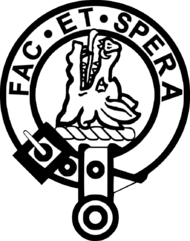 | |||
| Motto | Fac et spera (Latin = Do and Hope) | ||
| War cry | Battle cry: Cruachan![3] | ||
| Profile | |||
| District | Castle Martin,[4][5][6] County Kildare.[7][8] Achnacroish[9] and Ardrishaig, Argyllshire. Possil, Lanarkshire.[10] Craigenputtock Dumfriesshire.[11] | ||
| Plant badge | Shamrock[12] and Bog Myrtle[13] | ||
| Animal | Rampant Combatant Lions,[14] Talbot and Wild Boar[15] | ||
| Pipe music | "The Campbells are Coming"[16] | ||
| Carter-Campbell of Possil has no chief, and is an armigerous clan | |||
| |||
| |||
| |||
| |||
| Cailean Donncath (Χ dar Possele)[19] | |
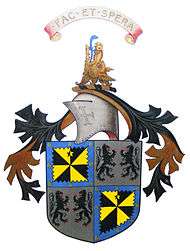 | |
| has no chief, and is an armigerous clan | |
| Last head | |
| Seat | Craigenputtock[20] |
|---|---|
| Historic seat | Possil[21] |
| Last Chief | Lt. Col. Duncan Maclachlan Carter-Campbell of Possil OBE[22] |
 | |
| Motto | Victrix Patientia Duris (Latin = Patience is victorious in hardship) |
|---|---|
| has no chief, and is an armigerous clan | |
The family originates from two notable Scottish families. The Campbells of Possil were originally part of Clan Campbell, and located in Argyll; and the Carters were an Irish family, noted for their political involvement in the 18th century in Ireland. The Carter-Campbell name was first used in 1864, following marriage.
Since the marriage there have been a number of notable Carter-Campbell descendants, including Duncan Carter-Campbell of Possil OBE and George Carter-Campbell. Many of the Carter-Campbells in recent history have held high ranking positions within the British military.
Origins
Campbells of Possil
The Campbells of Possil's first origin in Scotland is in the area of Argyll (/ɑːrˈɡaɪl/), archaically Argyle (Earra-Ghàidheal in modern Gaelic, pronounced [ˈaːrˠəɣɛː.əl̪ˠ]), which is a region of western Scotland. The family is an extended branch of the Campbells of Kinloch and also the Campbells of Murthlie. These both have origins from the Campbells of Lawers.
Their links to the area of Argyll brought the original Campbells into problems in western Scotland, when Clan Campbell and Clan MacDougall had ongoing conflicts. Their regularly conflicts eventually resulted in the Battle of Red Ford. The battle took place in 1294, which resulted in the death of Sir Colin Campbell, who is said to be one of the first recognised Campbells in the Argyll region of Scotland. John MacDougall of Argyll is said to have led Clan MacDougall during the battle.[24]
The battle resulted in various Clan Campbell branches having ongoing feuds with Clan MacDougall. Both Clan Campbell and Clan MacDougall had influences in the region of Argyll, which meant there were ongoing feuds between the Scottish clans.[24]
The clan is directly descended from Sir Colin Campbell of Glenorchy, a Scottish nobleman born in the 15th century. Towards the end of the Middle Ages, a number of Campbells reached positions of power within Scotland, while under the reign of King James II. This continued into the reigns of King James III and also James IV of Scotland, where many Campbells became Earls of Argyll.
Carters
The Carter family originally descended from Thomas Carter, an Irish MP and are known as a political family. He was elected as an MP to the Irish House of Commons and became Second Sergeant at Arms being returned first for Fethard and then for Portarlington.[25]
His son also called Thomas Carter, was born in 1690. He was the first occupier of Castlemartin which he acquired in 1729, and was made Master of the Rolls in Ireland in 1731.[26] Thomas Carter was succeeded at Castlemartin by his second son Henry Boyle Carter, who was named after his father's friend and political ally, Speaker Boyle.
In 1750 Henry married Susanna Shaen, widow of James Wynne, daughter of Sir Arthur Shaen, 2nd baronet, and his Catholic wife Susanna Magan, by whom Henry had three sons and one daughter.
History
Early history
Sir Colin Campbell of Glenorchy was the second Earl of Argyll in 1457, after succeeding his grandfather, Duncan Campbell. After serving as Earl of Argyll, he became Lord Lorne in 1470. He became an earl after supporting King James II, against the Black Douglases.[27] Colin Campbell was the first Campbell earl in a list of Campbell Earls, who remained as Earls of Argyll until 1641.
17th century and civil war
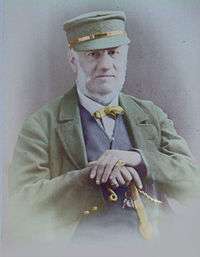
During the 17th century there were a number of Large Scottish Battles, which took place between 1644 and 1651.
The Campbell of Possil's first major involvement was at the Battle of Inverlochy in 1645. During this period, Clan Campbell and Clan Lamont fought in various battles across Scotland. Following the battle, Clan Lamont used the opportunity to destroy much of the Clan Campbell's territory in the area. This resulted in a backlash from Clan Campbell, and the Scottish clan took both Castle Toward and Castle Ascog from Clan Lamont as a result. Clan Chief James Lamont surrendered, and Clan Campbell burned both castles to the ground. This period of conflict became known as the Dunoon Massacre.[28][29]
Between 1647 and 1698, the Clan Campbell and Clan MacLean fought numerous battles around the area of Argyll, where many of the Campbell of Possil ancestors were located. In 1647, members of Clan Campbell were defeated at Duart Castle, during a battle by Royalist troops of Clan MacLean. In 1678, Archibald Campbell, 9th Earl of Argyll, son of the Marquess of Argyll invaded the Isle of Mull and took land from Clan MacLean.[30]
Years after the invasion of the Isle of Mull, members of the Campbell of Possil family invaded Duart Castle in 1691 along with Archibald Campbell, 1st Duke of Argyll. The Castle was surrendered by Sir John Maclean, 4th Baronet.[31] The Castle was subsequently demolished, by Clan Campbell and eventually included as part of the Torosay Castle estate. It remained as a ruin until it was rebuilt in the 19th century.[32]
19th century and formation of Carter-Campbell
In the early 19th century, commissioned David Bryce to build Torosay Castle for the Campbell of Possil family.[33]
The two land owning families were the Carters of Castle Martin and the Campbells of Possil. The Carters of Castle Martin had origins in the region of County Kildare, Ireland and this is where most of their land was located. The Campbells of Possil owned large areas of land throughout Lanarkshire.[34]

The marriage took place between Colonel Thomas Tupper Carter and Emily Georgina Campbell of Possil IV, who was granddaughter of Colonel Alexander Campbell of Possil.[35][36][37] Once married, their matrimonial home was the Fascadale estate,[38] Ardrishaig, Argyllshire. Emily Georgina Campbell of Possil IV wished to retain her surname when the marriage took place, which resulted in the formation of the Carter-Campbell name.[39]
Following the marriage in 1864, the family of Carter-Campbell was formed after the union of the two land owning families. Following the union of these two families their Armorial Bearings of the two families was merged in 1864. The Lord Lyon King of Arms in Scotland officially formed the Carter-Campbell of Possil Armorial Bearings.[34][40]
In late 1857 Carter joined the company's Royal Bengal Engineers and was promoted to first lieutenant on 27 August 1858.[41]
In 1861, Carter served in the Sikkim Expedition. In 1863, he commanded the engineer forces in the Umbeyla Campaign. On 21 April 1864, Carter was appointed a 3rd Grade surveyor in Great Trigonometric Survey of India.[42] Later that year, on 15 September, he was married to Emily Georgina Campbell of Possil, the daughter of General George Campbell of Inverniell and he adopted the new name of Carter-Campbell of Possil.
Carter served in the 1868 Expedition to Abyssinia where, upon the death of H. W. Garnault, he was promoted to captain on 13 September 1870.[43]
On 1 October 1877 Carter was promoted to major in the Royal Engineers,[44] and made lieutenant colonel on 11 December 1886.[45] He retired in 1887 upon receiving the honorary rank of colonel.
Carter lived for a time at Siam House, Weymouth, Dorset.[46] In 1893 he was granted renewed arms by the Lord Lyon King of Arms, and formally changed his name to Carter-Campbell of Possil.[46][47]
He subsequently lived with his wife and children at the family residence of Fascadale, in the parish of South Knapdale in Strathclyde (now Ardrishaig, Lochgilphead, Argyllshire).[48]
20th century onwards
On 14 January 1900 Carter died at Fascadale, aged 61.[49][50]
The family had other military involvements during the same period and beyond. Carter had six children, his son George Carter-Campbell served in World War I and became a major general. Duncan Carter-Campbell of Possil was another of Carter's sons, and was a British Army Colonel during the 1950s.[51]
Clan profile
Notable bearers
The notable bearers included:
| Portrait | Name | Birth | Death | Family | Known for |
|---|---|---|---|---|---|
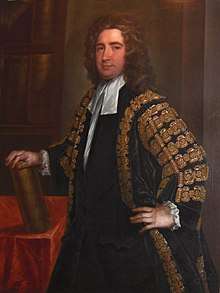 | Thomas Carter | 1690 Hollybrook, Dublin, Ireland | 3 September 1763 Rathnally House, near Trim | Unknown | Irish MP and first occupier of Castlemartin[52][53][54] |
 | Admiral John Carter | 1785 Castlemartin | 2 April 1863 (aged 77–78) Devonport | son of Thomas Carter and Catherine Butler of Castlemartin | Officer of the Royal Navy[55] |
| Colonel Thomas Tupper Carter-Campbell of Possil | 15 September 1838 | 14 January 1900 | the third son of Admiral John Carter RN of Castlemartin and his wife, Julia Adery Georges.[1] He was a grandson of Thomas Carter MP of Castlemartin. | British Soldier | |
| Colonel Alexander Campbell of Possil | Unknown | Unknown | Son of John Campbell (original owner of Estates of Possil | 10 November 1796 was appointed Colonel of the 7th West India Regiment.[56][57][58][59] | |
| Duncan Carter-Campbell of Possil OBE | 1911 The Island of Malta | 1990 Dumfriesshire | Son of George Carter-Campbell | British Army Colonel during the 1950s, received OBE | |
 | George Carter-Campbell | 1869 Edinburgh | 1921 (aged 51 or 52) London | Son of Thomas Tupper Carter-Campbell of Possil[60] | became Major General in 1915 |
Crests and coats of arms
| GLENORCHY 1420 - 1556 |
 1475 |
LAWERS 1475 - 1616 |
MURTHLIE 1525 |
 1600 - 1776 |
 1750 - 1772 |
|---|---|---|---|---|---|
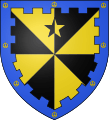 1780 -1809 |
POSSIL 1780 - 1892 (Lamont-Campbell) |
 1780 - 1952 (Carter-Campbell) |
COLGRAIN 1800 - 186 |
 1946 |
 1960 - 1966 |
 Campbell of Possil, Lanarkshire, Scotland coat of arms. Fac et Spera (Do and Hope)
Campbell of Possil, Lanarkshire, Scotland coat of arms. Fac et Spera (Do and Hope)
 Carter of Castle Martin crest badge on Irish saffron
Carter of Castle Martin crest badge on Irish saffron
Motto: Patience is victorious in hardship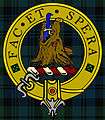 Campbell of Possil crest badge on ancient Campbell tartan
Campbell of Possil crest badge on ancient Campbell tartan
Motto: Do and Hope
Tartans
The tartans attributed to the family:
 Ancient Campbell tartan
Ancient Campbell tartan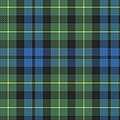 Campbell of Breadalbane tartan
Campbell of Breadalbane tartan Irish Saffron
Irish Saffron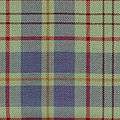 The tartan of County Kildare
The tartan of County Kildare
Estates
Torosay Castle, Isle of Mull
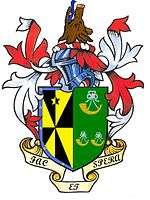
The Castle was built by the architect David Bryce for John Campbell of Possil. The castle was built in Scottish Baronial style, and completed in 1858.[33]
7 years after the construction of the castle, it was sold by John Campbell, to the wealthy businessman Arburthnot Charles Guthrie. The castle was sold in 1865. The castle was later sold to the Guthrie family, and is now commonly acknowledged as the seat for Clan Guthrie.[33]
John Campbell of Possil[61] (nicknamed "The Dragoon")[62] who was the son of Colonel Alexander Campbell of Possil,[63][64] employed architect, David Bryce,[65] and built the castle on the Isle of Mull[66] on the Torosay estate[68] after acquiring it from his father[69][70] in 1858.[71] The armorial bearings of the Campbells of Possil and the Crest, as shown above, are carved in stone[72] and displayed on each elevation of the castle walls.[73]
The Carter-Campbell family sold Torosay Castle in 1865. John Campbell of Possil sold the castle and the estate to Arburthnot Charles Guthrie, a wealthy London businessman. Torosay Castle is still standing, and in 2008 was the location where a priceless bottle of Veuve Clicquot champagne was found in the Castle. It was regarded as priceless by many, and is now on show display at the Veuve Clicquot visitor centre in Reims, France.[74]
Duart Castle
Duart Castle was originally built in the 13th century, and was part of Clan MacLean.[31] in 1350, Lachlan Lubanach Maclean of Duart was given the Castle as her dowry. The Clan Campbell's first involvement was an attack in 1647, and Archibald Campbell, 9th Earl of Argyll finally captured the Castle in 1691.[31] The Castle was then demolished, leaving the Castle in ruin. Large bricks from the ruins of the Castle were used by Donald Maclean, 5th Laird of Torloisk, to build a cottage for his family close to the Castle. By 1751, the castle has been abandoned and was officially part of the Torosay Castle estate.[32]
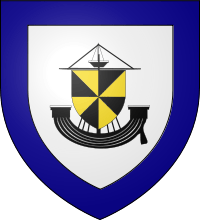
Descendants of Archibald Campbell, 1st Duke of Argyll sold the castle in 1801. It was purchased by Clan MacQuarrie, before it was sold to Carter-Campbell of Possil, who kept the Castle as a ruin in the Torosay estate. When the estate was sold, the Castle ruin was purchased by Sir Fitzroy Donald Maclean and restored.[31]
Possil Estate
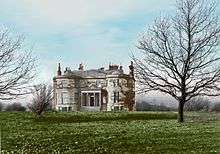
A region known as Nether Possil was acquired by Robert Crawford in 1595. From this point onwards, the estate was sold between various wealthy Scottish families, until the writer John Forbes built a house in 1697. In 1808, the estate was acquired by Colonel Alexander Campbell, son of Glasgow merchant John Campbell senior, founder of the west Indian trading house of John Campbell sen. & Co. Colonel Campbell has served during the battles in South Africa, being present at the capture of the Cape of Good Hope in 1806, and at the Battle of Corunna where he commanded the 20th Regiment. Having bought the adjoining estate of Keppoch in 1838, the family seat had transferred there. Campbell rented Possil house and a park to Sir Archibald Alison, 1st Baronet, who as the lawyer son of Scottish writer Archibald Alison, had in 1834 become Sheriff of Lanarkshire.
The house and parts of the estate went on to become the Possilpark area of Glasgow.
Clan Campbell of Possil Family Mausoleum
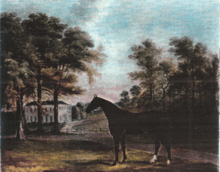
The Clan Campbell of Possil has a family mausoleum, which is located in the Parkland within the grounds of Torosay Castle.[75][76] A number of family members were buried there, following the purchase of the Torosay Estate in 1808. The following family members are buried at the mausoleum.
- Colonel Alexander Campbell of Possil[77] - Following the purchase of the Estate in 1808, Campbell of Possil decided to build a family mausoleum. Following its construction, he was the first person to be buried there.[78][79]
- Harriet Maclachlan[80] - Married Alexander Campbell of Possil, and was laid to rest in the Campbell of Possil Family Mausoleum. Before marriage, she was part of Clan Maclachlan and the daughter of Donald Maclachlan.[81]
- Mrs Alexander Campbell of Possil Née Harriet Maclachan of Castle Lachlan, Argyll[82] (see Clan Maclachlan painted by Sir Henry Raeburn[83]).[84]
- John Campbell of Possil Esq.[85] and of Torosay Castle[86] (Duart House[87]) The Achnacroish Estate,[88] Isle of Mull[89] and his three wives: Elizabeth Campbell of Ballimore,[90] Helen Bogle Campbell of Colgrain[91] and Elizabeth[92] daughter of Donald Horne W.S.[93]
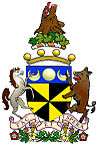
References
- Oxford Companion to Scottish History, p.64 – 66. Edited by Michael Lynch, Oxford University Press. ISBN 978-0-19-923482-0.
- "Babylon Gaelic Translate". Cairtear. Babylon.com LTD.
- Keltie, John. "Campbell of Argyll". celticbug.
- Burke, Sir Bernard (1852). A genealogical and heraldic dictionary of the landed gentry of Great Britain & Ireland for 1852: comprising particulars of upwards of 100,000 individuals. Volume 1. Colburn and Co.
carter of castle martin.
- Burke, Bernard; Townsend, Peter (1965). Burke's genealogical and heraldic history of the landed gentry. Volume 3. Burke's Peerage.
- Burke, Sir Bernard (1853). Index to Burke's Dictionary of the landed gentry of Great Britain & Ireland: comprising all the names (upwards of 100,000) mentioned in the work. Hurst and Blackett.
- Kavanagh, Michael V. (1976). A contribution towards a bibliography of the history of County Kildare in printed books. Kildare County Council.
- Burke, Sir Bernard (1852). A Genealogical and Heraldic Dictionary of the Landed Gentry of Great Britain & Ireland for 1852: Comprising Particulars of Upwards of 100,000 Individuals. Volume 3. Colburn and Co.
carter of castle martin.
- Great Britain. Parliament. House of Commons (1851). Parliamentary papers,. Volume 26. HMSO.
- Burke, Sir Bernard (1937). Genealogical and heraldic history of the landed gentry: founded by the late Sir Bernard Burke. Volume 3. Shaw.
- TheGlasgowStory. "Possil House". Sp Coll Dougan Add. 73 TheGlasgowStory. Glasgow University Library, Special Collections, Dougan Collection.
- McCalmont, Rose Elizabeth; Barret, C. R. B. (1915). Memoirs of the Binghams. Spottiswoode.
carter of castle martin.
- A History of Clan Campbell Vol.1, p.294. by Alastair Campbell of Airds, Edinburgh University Press. ISBN 1-902930-17-7.
- Stevenson, Robert Louis (1897). Works. Volume 13. C. Scribner's.
- Beauclerk Dewar, Peter (1 August 2001). Burke's landed gentry of Great Britain. Burkes Peerage & Gentry Llc; 19th edition (August 2001). pp. 183, 184. ISBN 9780971196605.
- Seaver, Jesse Montgomery (1971). Campbell family history. American Genealogical Research Institute.
- "Official List of Septs of Clan Campbell". Retrieved 3 June 2007.
- Campbell, A, A History of Clan Campbell; Volume 1, From Origins to the Battle of Flodden, p.254-255
- Montgomery-Massingberd, Hugh (1976). Burke's family index. Burke's series. Burke's Peerage.
- Circle, Carlyle Craigenputtock (18 October 2007). "Dumfries and Galloway Council Public Enquiry Statement". Public Inquiry Statement. Dumgal, Carlyle Craigenputtock Circle.
- Smith, John Guthrie; Mitchell, John Oswald (1878). "The old country houses of the old Glasgow gentry". LXXXIII. Possil. Glasgow Digital Library.
- "Burke's Peerage & Baronetage 107th Edition, Burke's Landed Gentry 19th Edition". Carter-Campbell of Possil. Burke's Peerage & Gentry.
- Clan Campbell Society (United States of America) (1999). Journal of the Clan Campbell Society (United States of America). Volumes 26-28. The Society.
- Way, George and Squire, Romily. Collins Scottish Clan & Family Encyclopedia. (Foreword by The Rt Hon. The Earl of Elgin KT, Convenor, The Standing Council of Scottish Chiefs). Published in 1994. Pages 216 – 217.
- Henry Colin Gray Matthew, Brian Howard Harrison, British Academy. Oxford dictionary of national biography. ISBN 0-19-861360-1.CS1 maint: multiple names: authors list (link)
- Evans, Richard K (2007). The Ancestry of Diana Princess of Wales; for Twelve Generations. New England Historic Genealogical Society Boston Massachusetts. pp. 91, 143 (Thomas Carter). ISBN 0-88082-208-2.
- Hughes, Oliver Wynne (1989). Every day was summer: childhood memories of Edwardian days in a small Welsh town. Gomer Press.
- "Massacre of Clan Lamont and the Memorial at Dunoon". Lamont-young.com. Retrieved 10 November 2012.
- "Clan Lamont". Electricscotland.com. 29 July 1913. Retrieved 10 November 2012.
- MacLean, John Patterson (1889). A History of the Clan MacLean from Its First Settlement at Duard Castle, in the Isle of Mull, to the Present Period: Including a Genealogical Account of Some of the Principal Families Together with Their Heraldry, Legends, Superstitions, Etc. R. Clarke & Company. p. 224.
The MacLeans, not yet recovered from the disastrous effects of the battle of Inverkeithing, were upon this occasion illy prepared to resist the invasion of such a force. The Campbells landed in Mull in three different places, without opposition, the inhabitants contenting themselves with removing into the mountains and fastnesses of the island for protection, with their cattle. The young chief, to shield him from personal harm, was sent to the castle of Cairnbulg, and afterward to Kintail under the care of the Earl of Seaforth.
- "MacLean". Electric Scotland. Retrieved 26 August 2007.
The castle dates from the thirteenth century, and was repaired and enlarged by Hector Mor Maclean, who was Lord of Duart from 1523 till 1568. In 1691 it was besieged by Argyll, and Sir John Maclean, the chief of that time, was forced to surrender it. After that date, though occasionally occupied by troops, the stronghold gradually fell to ruins, and the Duart properties passed to other hands till Sir Fitzroy repurchased Duart itself in 1912.
- Fryer, Mary Beacock, Allan Maclean, Jacobite General: The life of an eighteenth century career soldier, Dundurn Press, Toronto, 1987, p.16
- "Torosay Castle". Isle of Mull. Retrieved 17 February 2014.
- The Sessional Papers. 1904.
- The Biographical Edition of the Works of Robert Louis Stevenson: Virginibus puerisque. Volume 18 of The Biographical Edition of the Works of Robert Louis Stevenson. C. Scribner's Sons. 1911.
campbell of possil.
- Reports From the Select Committee on Sites for Churches (Scotland). 1847.
- The Quarterly Journal of Agriculture. William Blackwood and Sons. Edinburgh. 1843. p. 671.
campbell of possil.
- Royal Geographical Society (Great Britain) (1898). Year-book and record.
- The Scottish law reporter: continuing reports ... of cases decided in the Court of Session, Court of Justiciary, Court of Teinds, and House of Lords. Volume 38. W.&R.A. Veitch. 1900.
- "The London Gazette" (PDF). The London Gazette. 29 April 1862. p. 2239.
- Hart, Col. H. G. (1868). The New Army List; and Militia List. The London Gazette. p. 101a.
- "The London Gazette" (PDF). The London Gazette. 13 December 1870. p. 5748.
- "The London Gazette - The Morning Post" (32898). London, England. 5 December 1877. p. 6.
- "Military News - The Star" (87). Saint Peter Port, England. 16 December 1886.
- "Change of Name". Morning Post (37674). London. 11 March 1893. p. 1.(subscription required)
- Anderson, J.; Anderson, F. (22 October 1895). "[Notice]" (PDF). Edinburgh Gazette. pp. 1373–4.
- Anderson, J.; Anderson, F. (22 July 1898). "[Notice]" (PDF). Edinburgh Gazette. p. 728.
- "Obituary". The Times (36040). London. 16 January 1900. p. 7.(subscription required)
- "Naval and Military News". Birmingham Daily Post (12979). Birmingham. 17 January 1900.(subscription required)
- Ellis, Patricia (1990). Debrett's people of today. Debrett's Peerage Limited.
- Debrett, John (1822). The Peerage of the United Kingdom of Great Britain & Ireland. Volume 2.
- Debrett, John (1822). The Peerage of the United Kingdom of Great Britain & Ireland. Volume 2.
- Debrett, John (1838). TDebrett's complete peerage of the United Kingdom of Great Britain and Ireland. Volume 2. Printed for J.G. & F. Rivington.
- The Gentleman's Magazine. 214. p. 802.
- The Edinburgh almanack, or Universal Scots and imperial register. Printed by Oliver & Boyd. 1831.
- McColl, Evan (2009). The Mountain Minstrel; Clàrsach Nam Beann: Counting of Original Poems and Songs. BiblioBazaar, LLC. ISBN 9781113558428.
- International auction records. Volume 25. Editions Publisol. 1991.
- The Art quarterly. Volume 34. Metropolitan Museum of Art. 1971.
- "Obituary: Death of Colonel Carter-Campbell". The Times. The Times Digital Archive. 21 December 1921. p. 14.
- The Sessional Papers of the House of Lords: Session 1854-5, Vol XXXIV. 1855.
- The Journal of Jurisprudence, Volume 3. T.T. Clark. 1888.
campbell of possil.
- The House of Lords Session 1847-8. House of Lords. 1848.
- Norman Macleod (2002). Morvern: a Highland parish. Birlinn. ISBN 9781841582375.
- Graham Ritchie, Mary Harman; Anna Ritchie (1996). Argyll and the Western Isles, Exploring Scotland's heritage. HMSO. ISBN 9780114952877.
- William Pulteney Alison (1844). Remarks on the report of her majesty's commissioners on the poor-laws of Scotland and on the dissent of mr. Twisleton from that report. W. Blackwood&Sons. p. 126.
campbell of possil.
- Transactions of the Gaelic Society of Inverness. Volume 57. Gaelic Society of Inverness. 1993.
- Society for the Benefit of the Sons and Daughters of the Clergy (1845). The New Statistical Account of Scotland: Renfrew, Argyle. Volume 7 of The New Statistical Account of Scotland. W. Blackwood and Sons. p. 286.
campbell of possil.
- Samuel Lewis (1846). A topographical dictionary of Scotland, comprising the several counties, islands, cities, burgh and market towns, parishes and principal villages. Volume 2. Lewis.
- The Scottish jurist: containing reports of cases decided in the House of Lords, Courts of Session, Teinds, and Exchequer, and the Jury and Justiciary Courts. Michael Anderson. 1859.
- James Truscott; Hugh Palmer (1988). Private gardens of Scotland. Harmony Books.
- Israel Shenker (1984). In the Footsteps of Johnson and Boswell A Galaxy Book. Oxford University Press.
- "Priceless champagne discovered". BBC News. 28 July 2008. Retrieved 26 July 2009.
- Donald Omand (2004). The Argyll book. Birlinn.
- John N. MacLeod (1898). Memorials of the Rev. Norman MacLeod (senr) D. D.: minister of St. Columba's Church, Glasgow, dean of the Chapel Royal and one of Her Majesty's chaplains for Scotland. D. Douglas.
- Correspondence from July, 1846, to February, 1847, relating to the measures adopted for the relief of the distress in Scotland. W. Clowes & sons. 1847.
- Samuel Lewis (1989). A Topographical Dictionary of Scotland: From Abbey to Jura. Volume 1 of A Topographical Dictionary of Scotland: Comprising the Several Counties, Islands, Cities, Burgh and Market Towns, Parishes, and Principal Villages with Historical and Statistical Descriptions. Genealogical Pub. Co.
- Robert Louis Stevenson. Works: "Virginibus puerisque" and other papers. Dr. Jekyll and Mr. Hyde. Volume 2 of Works. Collier.
- Robert Louis Stevenson (1929). Virginibus puerisque: Familiar studies of men and books Issue 765 of Everyman's library. J. M. Dent & sons, ltd.
- Robert Louis Stevenson (1906). The Works of Robert Louis Stevenson.
campbell of possil.
- Frank Arneil Walker; Fiona Sinclair (2000). Argyll and Bute The buildings of Scotland Pevsner architectural guides. Penguin in association with Buildings of Scotland Trust.
- The art sales index. Volume 2. Art Sales Index. 1989.
- John N. MacLeod; Sir Leslie Stephen; Sir Sidney Lee (1894). Dictionary of national biography. Volume 37. Smith, Elder, & co.
- Edinburgh Academy. Academical Club, Thomas Henderson, Philip F. Hamilton-Grierson (1914). The Edinburgh Academy register: a record of all those who entered the school since its foundation in 1824. Volume 37. s.n.CS1 maint: multiple names: authors list (link)
- J. P. MacLean (2008). Renaissance of the Clan MacLean: Comprising Also a History Od Dubhaird . BiblioBazaar, LLC.
- James Lumsden (1839). Lumsden & Son's Steam-boat companion, or, Stranger's guide to the Western Isles and Highlands of Scotland: including the voyages from London to Leith, and from Glasgow to Liverpool & Belfast : with a land tour to the Giant's Causeway, &c. : also a short tour to the lakes of Cumberland. James Lumsden & Son. p. 142.
campbell of possil.
- William Craig Maxwell (1857). Iona and the Ionians: Their manners, customs, and traditions, with a few remarks on Mull, Staffa, and Tyree. T. Murray and Son. p. 42.
campbell of possil.
- Royal Commission on the Ancient and Historical Monuments and Constructions of Scotland; Sir Leslie Stephen; Sir Sidney Lee (1971). Mull, Tiree, Coll & Northern Argyll (excluding the Early Medieval & later monuments of Iona) Volume 3 of Argyll: An Inventory of the Ancient Monuments, Royal Commission on the Ancient and Historical Monuments and Constructions of Scotland Volume 21 of Report of the Royal Commission on the Ancient and Historical Monuments of Scotland. H.M.S.O. ISBN 9780114915919.
- Peter Furtado; Sir Leslie Stephen; Sir Sidney Lee (1987). The Ordnance Survey guide to historic houses in Britain - Ordnance Survey Guides Series. Norton. ISBN 9780393304015.
- David Herbert (1883). Fish and fisheries: a selection from the prize essays of the International fisheries exhibition, Edinburgh, 1882. W. Blackwood and sons.
campbell of possil.
- John Mackay; Annie Maclean Sharp Mackay (1907). The Celtic monthly: a magazine for Highlanders. Volume 15. Archibald Sinclair, Celtic Press.
- Henry Colin Gray Matthew, Brian Howard Harrison, British Academy (2004). Oxford dictionary of national biography: in association with the British Academy : from the earliest times to the year 2000. Volume 37. Oxford University Press. ISBN 9780198613879.
campbell of possil.
CS1 maint: multiple names: authors list (link)
Further reading
- A history of Clan Campbell, vol. 1: From origins to Flodden by Alastair Campbell of Airds Unicorn Pursuivant (pages 206, 209), books.google.co.uk
- Campbell of Airds, Alastair (2005). A History of Clan Campbell; Volume 3,From the Restoration to the present day. Edinburgh: Edinburgh University Press. pp. 350, 340, 643, 1530, 282, 248, 339, 427. ISBN 0-7486-1790-6.
- The Island & Its People. By Jo Currie (pages 197, 225, 238, 256, 281, 310-312, 319, 326, 331, 332, 333, 366, 372, 384, 403)., books.google.com
- Kelvingrove Art Gallery and Museum Glasgow (Campbell family portraits by Sir Henry Raeburn), glasgowmuseums.com
- Fairbairn's Book of Crests of the Families of Great Britain and Ireland, genealogical.com
- The Irish Book of Arms: Armorial Bearings of Ireland and Her Families from the Earliest Times., books.google.co.uk
External links
- Carter-Campbell pages in Burke's Landed Gentry, books.google.com
- Craigenputtock website, residence of the Carter-Campbells, craigenputtock.eu
- Carter-Campbell of Possil page in Burke's Peerage and Gentry, burkes-peerage.net
- The Peerage.com
- The old country houses of the old Glasgow gentry: LXXXIII. Possil, gdl.cdlr.strath.ac.uk
- James Irvine-Robertson's Journal from 1845-1847 (Mull Diaries), jamesirvinerobertson.co.uk
- The Glasgow Story, John Campbell of John Campbell Snr & Co.
- The Glasgow Story, Mungo Nutter Campbell of Ballimore